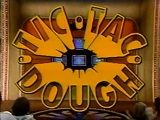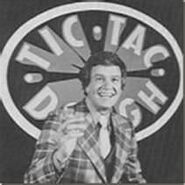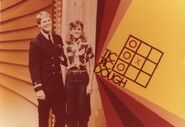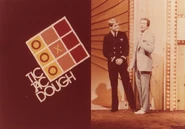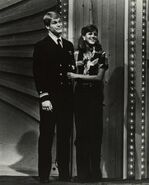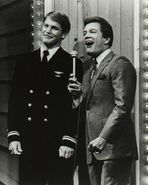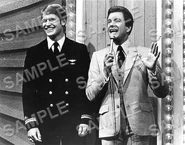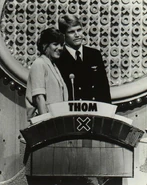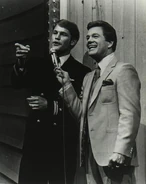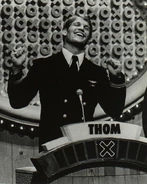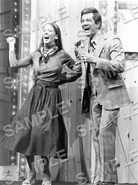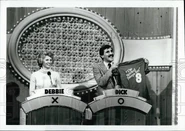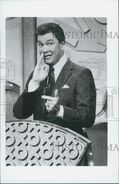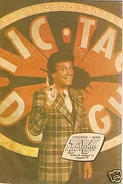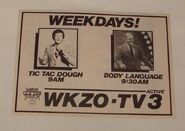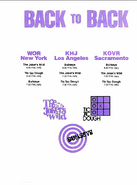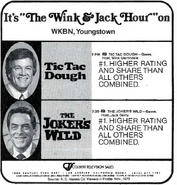| Aired | |
| CBS Daytime, July 3, 1978 - September 1, 1978; Syndicated, September 18, 1978 - May 23, 1986 | |
| Run time | |
| 30 Minutes | |
| Host | |
| Wink Martindale (CBS 1978 & Syndicated 1978-1985), Jim Caldwell (Syndicated 1985-1986) | |
| Announcer | |
| Jay Stewart (1978-1981), Charlie O'Donnell (1981-1986), Mike Darow 1980, Bob Hilton (1980), Art James (1980), Johnny Gilbert (1984) | |
| Origination | |
| Studio 31, CBS Television City; KCOP TV Studios, Los Angeles, California; The Production Group, Hollywood, California | |
This is chronicling the CBS daytime and syndicated 1978 revival of Tic Tac Dough.
Game Format[]
Main Game[]
Two contestants, one a returning champion playing "X", the other the challenger playing "O", faced a tic-tac-toe style game board. On the board are nine categories in nine boxes. The contestants in turn picked a category, then the host asked a question under that category. A correct answer won the box by placing his/her symbol in it, an incorrect answer meant the box remained unclaimed. After each turn (originally after each round), categories shuffled to different positions. The object of the game was to place three Xs or Os in a row, either across (horizontally), up and down (vertically), or diagonally.
Along the way, correct answers also added money the pot. In the short-lived daytime run, the outside boxes were worth $100, while the center box was worth $200. In the nighttime run, the outside boxes were worth $200, while the center box was worth $300. The questions there were tougher; in fact they were all two-parters, and the player in control was given extra time to think it over.
During the CBS run, categories could appear in either a blue background box (which meant the player who selected the category was the only one who responded to the question) or a black background box (which meant the question was a "jump-in" for both players, using the buzzers on their podiums). This did not affect the value of the questions. In addition, if a game ended in a tie, one final "jump-in" question would be asked to determine the winner of the game. The black boxes were eliminated in the syndicated run, and all questions were for just the controlling player(s) until the addition of the "Red Box" categories (see below).
The first player to get tic-tac-dough won the game, became Tic Tac Dough champion, took all the money in the pot, and went on to play the Tic-Tac-Dough bonus game. In the CBS run, if the game ended in a tie (eight boxes for both players with no chance for a win, or the board was completely filled-up), a toss-up question was asked to determine a winner, whereas on the syndicated run, a brand-new game was played with new categories, and the pot continued growing from the last total amount from the previous game. Starting in Season 2, losing challengers ("O" players) won $250 for each tie should he/she lose.
Champions in the CBS run stayed on the show until they were either defeated or exceeded the then CBS winnings limit of $25,000 or more. There was no limit whatsoever in the syndicated run; they just played till they lost. However, during the 1983-1984 season, players who won $50,000 donated every dollar over $50,000 to his or her favorite charity.
For every five matches won, champions were awarded a new car:
- Chevrolet Chevette ($3,800 in 1978, $5,600 from 1981-1982, $5,800 from 1982-1983, and $6,100 from 1983-1984)
- Buick Skylark ($5,200 in the first season and $5,400 in 1980)
- Buick Century ($5,300 from 1979-1980 and $6,500 from 1980-1981)
- AMC Eagle wagon ($12,500 during Martindale's final season)
- Mazda GLC ($10,500 during the final Jim Caldwell season).
The Red Categories[]
Starting in Season 2 of the syndicated run, certain categories appeared in a red background (regular ones appeared in a blue background). Those were very special categories. Some had special questions, some could affect the outcome of the game, and others allowed both contestants to play. None of them appeared in the center box, for none of them had two-part questions.
- Secret Category – This was the show's very first red category, which first appeared in the lower right hand corner at the start, then later appeared in the bottom center at the start. The Secret Category was a mystery, for it could be any category at all. A correct answer to the question from that category doubled the total of the pot, thus making pot values occasionally worth more than $10,000, with two of the biggest pot values in the history of the series being worth $38,100 (won by Tom O'Connor), and the other pot worth $36,800 (won by Thom McKee). The largest pot in series history, $46,900, was won after the Secret Category was retired. This, of course, was inspired by the "Mystery Category" from the syndicated 70's era of The Joker's Wild.
- Jump-In Category – The host would read the question to both contestants, and the first one to buzz-in got a chance to answer. A correct answer won the box, but an incorrect answer gave the opponent a chance to answer for the box, by hearing the entire question. In the CBS run, the Jump-Ins were identified by a black background behind 1, 2, or 3 categories, and in the earlier months, jump-ins were also played if the game ended in a tie. There were two other variations of that category that will be explained later.
- Challenge Category – This was where the contestant who selected the box decided to either answer the question himself/herself or challenge his/her opponent to do the same. A correct answer or a successful challenge won the box.
- Bonus Category – A three-part question was asked to the contestant in control. Answering all three parts correctly not only won the box, but also another turn. A Tic-Tac-Dough could be achieved by going for that category (either three times or twice plus one regular category) in three straight moves, causing the opponent to return to play another game.
- Opponent's Choice – So called because the opponent got to decide from which one of two categories he/she wanted the player in control to answer a question. In the final season, the contestant in control could be forced to answer two questions on one category, or one in another. This was the inspiration for the "Opponent's Choice" in Round 2 of the "Dollar" format of the 1990 era of The Joker's Wild.
- Play or Pass – This was where the contestant in control could decide, after hearing the question, to answer that question or pass it up for another question.
- Seesaw – One question with multiple answers was asked, and the contestants, starting with the player who selected the category, took turns answering the that question. Play continued until one of the contestants gave a wrong answer, repeated one, or ran out of time; if any of those things happened, the opponent won the box (the only time a contestant could win a box by default). The box could be also won by the contestant giving the last correct answer.
- Auction – A question with multiple answers was read. Then the contestants, starting with the player who selected the category, bid back and forth on how many answers they wanted to give. Bidding stopped when a contestant bid the max number, or forced the other to play. The winner of the bid had to then give the required number answers he/she bid on. Completing the bid won the box, but an incorrect answer somewhere down the line, allowed the opponent to try and give just one correct answer to win the box.
- Top Ten – A question with a number of ranked answers to it was asked. The contestant who chose the category had to then give the highest ranked answer on the list. Giving the number one answer or the higher ranked answer won the box; but an incorrect answer or a lower ranked answer gave the opponent a chance to answer. In the final season, Top Ten was renamed Top This.
- Double or Nothing – This was where a contestant could win two boxes in the same turn. A correct answer from one question earned the right to try and win another box. Answering the second question correctly won both boxes, but answering incorrectly earned nothing. The board did not shuffle in between categories. Originally, the contestant in control could decide not to go for another box, or take that risk.
- Trivia Challenge – A multiple-choice question was asked to both contestants. The one who selected the box decided to either answer the question first, or dare his/her opponent to answer. The winner of the question won the box. This category was renamed Trivia Dare during the 1984–1985 season.
- Grand Question – Replacing the Secret Category in Fall 1983, a correct answer from this question added $1,000 to the pot.
- Take Two – Introduced in Fall 1985, the questions from this category had two clues. The contestant who chose the box could answer from the first clue just read, or risk losing the box by hearing the second clue and giving the opponent a chance to answer.
- It’s a Dilemma – In this category, the first clue to the correct answer was read, then the contestant who selected the box chose how many out of the remaining five to hear; however, the opponent had to then decide who should answer the question. This category appeared during the Jim Caldwell season.
- Number Please – Introduced in Fall 1985 and played like the Card Sharks questions, a question with a numerical answer was asked. The contestant who selected the box had to then take a guess, then the opponent guessed whether the actual number was higher or lower than the first contestant's guess. The actual number was then revealed, and a correct higher or lower guess won the box for the opponent, but an incorrect higher or lower guess or guessing the number on the nose won the first contestant the box.
- Showdown – Introduced during the Caldwell season, a series of two-part jump-in questions were asked. The first contestant to buzz-in had a chance to answer first, then the opponent got to answer. Play continued until one of them made a mistake, causing the opponent to win the box.
- Three to Win – A series of Jump-in questions were asked to both contestants, and the first one to answer three questions correctly won the box. This category was introduced in the fall of 1985.
Beat the Dragon (Bonus Game)[]
In the bonus game, winning contestants faced the board to which its nine boxes were numbered 1-9. Behind all but one of the numbers were either money amounts or various X's & O's, and some "WIN" symbols. Behind that one remaining number was a "dragon" icon. The winning contestant's job was to meet a certain goal before running into the mean green dragon. Every safe square usually earned money, which the player could stop and keep if he/she desired, or risk it to keep playing. Winning the bonus round earned a cash prize of at least $1,000 and a prize package worth between $2,000-$5,000. Finding the dragon ended the game and "burned" the money.
The CBS Bonus[]
In this bonus game, the board now consisted of eight tic-tac-toe symbols (four Xs & four Os) and only one dragon. The Xs & Os were jumbled up making sure that there was only one way to win. The winning contestant started calling off numbers, and for each symbol found (either X or O), $150 was added to the pot. Later in the run, if the player found that one Tic-Tac-Dough, the winning contestant's cash total was upped to $1,000 if he/she had less than that, unless of course the player uncovered a total of seven boxes (for $1,050) or all eight (for $1,200).
The Syndication Bonus[]
The board now had six money amounts ranging from $100-$500 (originally $50-$500), squares marked TIC & TAC, and of course, the dragon. The object of this game was to uncover money amounts and try to reach $1,000 or more (exactly $1,000 without going over for a brief time in 1983), or find the TIC & the TAC (which bumped the total to $1,000).
"Dragon Finder" Audience Game[]
For a time in 1983, an audience game called "The Dragon Finder" was instituted; it was played whenever the bonus round was won or a contestant stopped early. Instead of uncovering the board immediately to find the dragon, a randomly selected member of the studio audience was called upon to expose where the dragon was hidden behind the remaining numbers. The contestant in control chose a number from one of the remaining ones on the board to uncover the dragon. If that player failed, another audience member was chosen to do the same. Originally, finding the dragon was worth a flat $250. Later in the game's run, $50 was added for each unsuccessful pick. Also later on, each audience member who played received a Dragon Finder cap, which was introduced on a Friday "Hat Day" the week before that began (see "Hat Day" below).
For a brief period, two members of the studio audience played the "Dragon Finder" game. They were invited to expose where the dragon was hidden behind the remaining numbers. The contestants took turns choosing the remaining numbers on the board to uncover the dragon.
Special Tournaments[]
From Season 2 to 1983, the show held special tournaments featuring eight players usually competing for charity, with no pot in any game (nor red categories), and the loser playing the bonus for consolation money (with a little more awarded for hitting the dragon). The final match was best-of-three to determine the winner of the grand prize, while the runner-up received a smaller prize. If any game ended in a tie, the contestants were usually asked a question with multiple answers (similar to the Seesaw category), with the first to make a mistake automtatically losing.
Over-80 Tournaments[]
In Seasons 2 & 3, the participants were at least 80 years of age competing for themselves, as well as charity. The bonus was also played for $2,000 (with $500 added for hitting the dragon). In the end, the grand champion split $100,000 wiht their charity, while the runner-up received $5,000 for themselves. Unlike later tournaments, if a game ended in a tie, the contestants switched places for a new game.
Celebrity Tournaments[]
Between Spring 1981 and Spring 1983, the tournaments had a certain theme (sports figures, soap opera stars, Miss America and Classy Guys), each with eight celebrities of that theme participating. The bonus was played for $2,000 in the quarter-finals, and $3,000 in the semi-finals (with $500 added for hitting the dragon either way). In the end, the Grand Champion received $10,000 and the runner-up collected $5,000.
Tournament of Champions[]
In 1983, the show invited eight of its (at the time) all-time highest winners, all of whom earned a collective total of $1,248,500, back to play for charity. The bonus was played for $5,000 (with hitting the dragon adding $1,000). In the end, the Grand Champion earned $50,000 while the runner-up won $25,000.
Trivia[]
The show was distributed by Colbert Television Sales.
Wink Martindale was originally tapped to host its sister show, The Joker's Wild, but he wound up hosting Gambit instead. He did, however, host The Joker's Wild when it was a CD-i game for Philips Interactive.
Thom McKee, a lieutenant pilot in the United States Navy, was the biggest winner in the history of Tic Tac Dough, having won $312,700. His wife Jenny, whom he just married by the time he came to the show, assisted him mostly in playing the Beat the Dragon bonus game.
On Friday shows, Wink would always wear a viewer submitted hat. This day would be referred to as "Hat Day".
GSN ranked Tic Tac Dough #32 as one of The 50 Greatest Game Shows of All-Time in 2006. The special was hosted by Bil Dwyer.
International Versions[]
Main Article: Tic Tac Dough/International
Merchandise[]
Main Article: Tic Tac Dough/Merchandise
Photos[]
Tickets[]
Ads[]
Episode Status[]
See Also[]
Tic Tac Dough
Tic Tac Dough (1990)
Tic Tac Dough (2000 proposed pilot)
Tic Tac Dough (2021 Pilot)
Tic Tac Dough (2024)
Links[]
The Unofficial Tic Tac Dough Supersite
Rules for Tic Tac Dough at the Game Show Temple
Older Flash game for Syndicated version of Beat the Dragon

